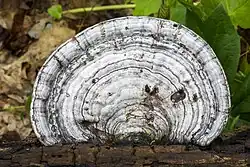Ganoderma megaloma
| Ganoderma megaloma | |
|---|---|

| |
| Scientific classification | |
| Kingdom: | Fungi |
| Division: | Basidiomycota |
| Class: | Agaricomycetes |
| Order: | Polyporales |
| Family: | Ganodermataceae |
| Genus: | Ganoderma |
| Species: | G. megaloma
|
| Binomial name | |
| Ganoderma megaloma (Lév.) Bres. (1912)
| |
Ganoderma megaloma is a species of bracket fungus in the family Ganodermataceae.
The fungus was described as new to science in 1846 by mycologist Joseph-Henri Léveillé, with the holotype being collected in New York. It was moved into the genus Ganoderma by Giacomo Bresàdola in 1912.[1] The species is closely related to Ganoderma applanatum.
G. megaloma is found in the eastern and midwestern United States. It causes white rot and butt rot on living hardwoods.
References
- ^ Bresadola G (1912). "Hedwigia 53". Hedwigia. 53 (54).
External links